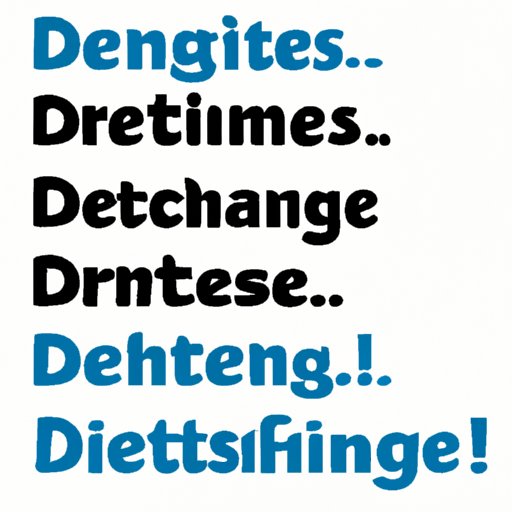Introduction
Greetings are an essential part of German culture and etiquette. Whether you’re traveling to Germany, communicating with German-speaking colleagues, or simply interested in learning the language, it’s crucial to know how to say “hi” and other common greetings in German. However, with such a complex language and culture, it can be challenging to navigate the various greetings for different situations. This article aims to provide a comprehensive guide to German greetings, covering key vocabulary, pronunciation tips, and cultural norms.
“Sprechen Sie Deutsch?”: A Beginner’s Guide to Common German Greetings
Before diving into the nuances of German greetings, it’s important to start with the basics. The first step to initiating a conversation in German is to ask if the person speaks the language. “Sprechen Sie Deutsch?” means “Do you speak German?” and is a useful phrase to know.
Other common greetings for beginners to learn include:
- Hallo – Hello
- Guten Morgen – Good morning
- Guten Tag – Good day / Good afternoon
- Guten Abend – Good evening
- Tschüss – Bye
These easy greetings are perfect for beginners who want to initiate a polite conversation. While it may be tempting to stick to one greeting for all situations, it’s essential to know which greeting to use based on the context and relationship between speakers.
A Quick Introduction to German: How to Say Hi and Other Basic Greetings
Once you’ve mastered the basics, it’s time to learn more advanced greetings. These greetings are ideal for more formal or professional settings, such as business meetings, interviews, or conferences.
Examples of advanced greetings include:
- Guten Tag, wie geht es Ihnen? – Good day, how are you? (formal)
- Guten Abend, wie geht es Ihnen? – Good evening, how are you? (formal)
- Es freut mich, Sie kennenzulernen – Nice to meet you (formal)
- Auf Wiedersehen – Goodbye (formal)
While similar in structure to the basic greetings, these phrases are more formal and show respect for the other person.
“Hallo!”, “Guten Tag!”, and Other German Greetings You Should Know
Germany has a unique culture and language, and it’s essential to understand the customs and norms of the country to communicate successfully. Formality is crucial in German greetings, and there’s a difference between formal and informal greetings.
Examples of formal greetings include:
- Guten Tag (Good day)
- Guten Abend (Good evening)
- Herzlich willkommen (Warm welcome)
On the other hand, informal greetings are commonly used between close friends or family members:
- Hallo (Hello)
- Tschüss (Bye)
- Servus (Hi/Bye, typically used in Southern Germany and Austria)
The usage of these phrases can also vary depending on the region of Germany you’re in. It’s crucial to learn the specific customs of the area you’re in to communicate effectively and respectfully.
Greetings in German: Simple Phrases to Make a Good First Impression
First impressions are vital in German culture, and it’s crucial to make a good one. Formal greetings are commonly used in professional settings to show respect and establish a positive image.
Examples of polite phrases to use when greeting someone formally include:
- Es freut mich, Sie kennenzulernen (Nice to meet you)
- Wie geht es Ihnen? (How are you?)
- Vielen Dank (Thank you so much)
These polite phrases can make a good impression and establish a positive relationship with the other person.
How to Properly Greet Someone in German: A Step-by-Step Guide
Greetings in German follow a specific process, and it’s essential to use the appropriate gesture and body language. The steps to greeting someone in German are as follows:
- Address the person with a formal or informal greeting
- Introduce yourself, if necessary
- Shake hands while maintaining eye contact
- Use polite phrases if appropriate
- End the conversation with a formal or informal goodbye
Using these steps can enhance your communication skills and show respect for the other person.
Mastering German Greetings: Tips and Tricks for Perfecting Your Pronunciation
Proper pronunciation is essential in German greetings, and it requires practice and patience. Common pronunciation errors for English speakers include the “ch” sound, umlauts (ä, ö, ü), and the “r” sound. Some tips for improving pronunciation include:
- Practicing speaking aloud
- Listening to native speakers
- Learning the IPA (International Phonetic Alphabet)
Practice exercises are also available online to improve your German pronunciation skills.
Conclusion
Greetings are an essential part of German culture, and it’s crucial to understand the nuances of the language and customs to communicate effectively. From basic greetings to more formal phrases, this article covered a comprehensive guide to German greetings. Proper pronunciation and body language are also crucial to enhance your communication skills. By using these tips and tricks, you can perfect your German greetings and make a positive impression on the people you meet.
